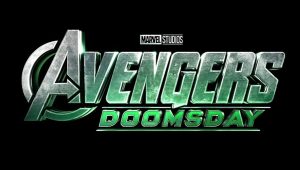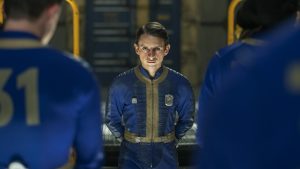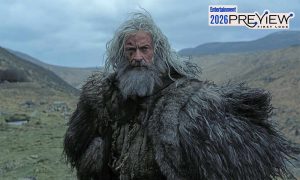
A robot sits along a riverbank and washes his face. The action serves an obvious utility. Moments earlier space fascists (which seem in overabundance these days) bullied the automaton, knocking his face into the dirt, and kicking him while he’s down. Still, it is in how Zack Snyder stages the machine’s cleansing ritual that sticks with me. Voiced by the endlessly regal Anthony Hopkins, our ostensible C-3PO appears to have the soul of Lear—or at least Odin given Rebel Moon’s visual lexicon.
The android waxes nostalgic about a slain king and tells a young girl who watches him bathe that her countenance provides him “with a feeling of warmth” and reverie as he recalls a princess who died. And when she puts literal flowers in his hair (gears?), the toaster with legs blushes. No, really, lights implanted in his face turn red. Does he feel embarrassment? Grief? That cool water in his hand, just as he claims to know what warmth is? When we see him later in the film, why has he donned the antlers of an elk, transforming his silhouette into that of a Viking god?
The appeal of Zack Snyder’s films is that the director is a master at crafting exactly such evocative images. Nearly every frame of his movies are the cinematic equivalent of a comic book penciler who draws only in splash pages. You’re encouraged to infer meaning and depth within every composition and atop each exceedingly stylized camera setup. Yet the meaning of it all is illusory, or at least no more profound than a teenager in the ‘70s replicating Dungeons & Dragons cover art on the side of his station wagon. It’s eye-catching, but to the uninitiated it comes across as more bemusing or hokey than illuminating.
Such is the breadth and totality of Snyder’s latest magnum opus, a space opera so grandiose it needed to be divided into two parts. Maybe the impetus for that choice will be clearer in April when the second half of the movie hits Netflix, but as of right now, Rebel Moon – Part One: A Child of Fire’s justification for its fractured structure is elusive. In effect, the film is another retelling of Seven Samurai, this time in space and also at a glacial place. Its other points of reference and imitation are equally glaring. Alien, Star Trek, and even fantasy epics like Game of Thrones and Harry Potter’s Hippogriff-riding all get nicked. Yet most prevalent, and oppressive, of the inspirations is Star Wars, which appears to have been doused in a beleaguering graywash, and with a dollop of nihilism, before getting tossed in a spin cycle and coming out like… this.
After all, Rebel Moon is about (surprise, surprise) a defiant rebel standing against an evil empire, although when we meet her she has no plans to ever fight again. Raised since childhood to be a foot soldier (or stormtrooper) for an imperial government centered around “Motherworld,” Kora (Sofia Boutella) has since sworn off violence and found peace on a small farming moon in the outskirts of the galaxy. Living in a provincial community that resembles a medieval Nordic village, Kora is content with life if not overjoyed. That changes on the day the Imperium arrives. Nothing but condescending smiles and malevolent, searching eyes, Admiral Atticus Noble (Ed Skrein) brings immediate violence and the threat of death to town. If this pastoral commune does not surrender its entire crop in 10 weeks’ time to Noble’s dreadnought, he will massacre everyone on the moon.
Kora’s first (and blessedly) brief instinct is to run, but after seeing imperial soldiers attempt to brutalize an underage girl, she has a change of heart—and plenty of slow-mo shots of her hacking at the brownshirts’ own vital organs too. She and the smitten farmer Gunnar (Michael Huisman) will traverse the stars in order to find a disgraced rebel general named Titus (Djimon Hounsou), insurgents in search of a leader, and other assorted rogues, scoundrels, and ciphers bereft of characterization. Together they’ll return to the Space Norsemen as magnificent heroes, ready to fight the might of the Imperium.
Much has been made in the press about how Snyder envisioned Rebel Moon as Star Wars for adults. Our own correspondent was told it’s George Lucas’ fantasy “but with violence, sex, and swearing.” Yet for all that alleged maturity, a viewer is left to ponder why is the sex, along with everything else in this universe, so uniformly violent? In Part One, we get graphic attempted space rape, leering space pedophiles, and even a most unwelcome hint of space tentacle foreplay. But any sense of emotional or healthy connection between grown-ups, romantic or otherwise, is absent. There are adult characters, to be sure, but the only way they communicate is through competitions of stoicism and adolescent brooding, exposition blather that sounds like a thousand other movies, or other hitherto unlisted forms of cruelty and depravity.
Despite existing in a galaxy with a thousand star systems and worlds, there is no sunlight in the thing. Or charm. It is an unrelentingly bleak cosmos that mistakes a lack of humor for a lack of life. At one point, a character muses that their newest idyllic location is a good place “to die.” None of them seem to spare a moment’s thought on what it might be like to really live.
At this point, dear reader, it should be pretty obvious Rebel Moon was not for me, nor would it be for anyone else who rolls their eyes at the thought of watching a Star Wars movie where the lightsabers are replaced by clubs, and when they hit someone, a shot of bloody teeth splattering across the floor will surely follow. It’s a derivative work that is full of despair. And yet, strangely, I cannot help but respect Snyder for getting to make it in exactly the shade of grim-dark he wanted.
Whatever shortcomings are inherent in the screenplay’s collection of clichés, the actual world-building onscreen is dense. The alien designs we witness at its Mos Eisley-like bar pull just as much from mythology as they do the works of Lucas or H.R. Giger. There are spider-women who look like something Theseus would fight in the Labyrinth, and one parasitical alien uses a human being as a meat puppet in a watering hole without anyone batting an eye. It’s even kind of nice to see Snyder double down on his use of speed-ramping slow motion again after all these years, which whether by design or accident turn flashbacks of Kora’s Space Nazi days into a regular intergalactic Leni Riefenstahl picture.
Rebel Moon has a soul and a personality imbued by the hands of its creator. I might personally find that soul to be repulsive, but in an age where so many big budget action movies and sci-fi products are scared of anything approaching a human touch—including the most recent Star Wars movie—and where everything is boiled down to the lowest common denominator of innocuous content, it’s nice that Snyder still gets to make exactly the movie he wants for exactly his kind of audience. Everyone else, however, should look for the escape pod now.
Rebel Moon – Part One: A Child of Fire opens in limited release on Friday, Dec. 15 and premieres globally on Netflix on Dec. 21.
The post Rebel Moon Review: At Least It’s Better Than The Rise of Skywalker appeared first on Den of Geek.











